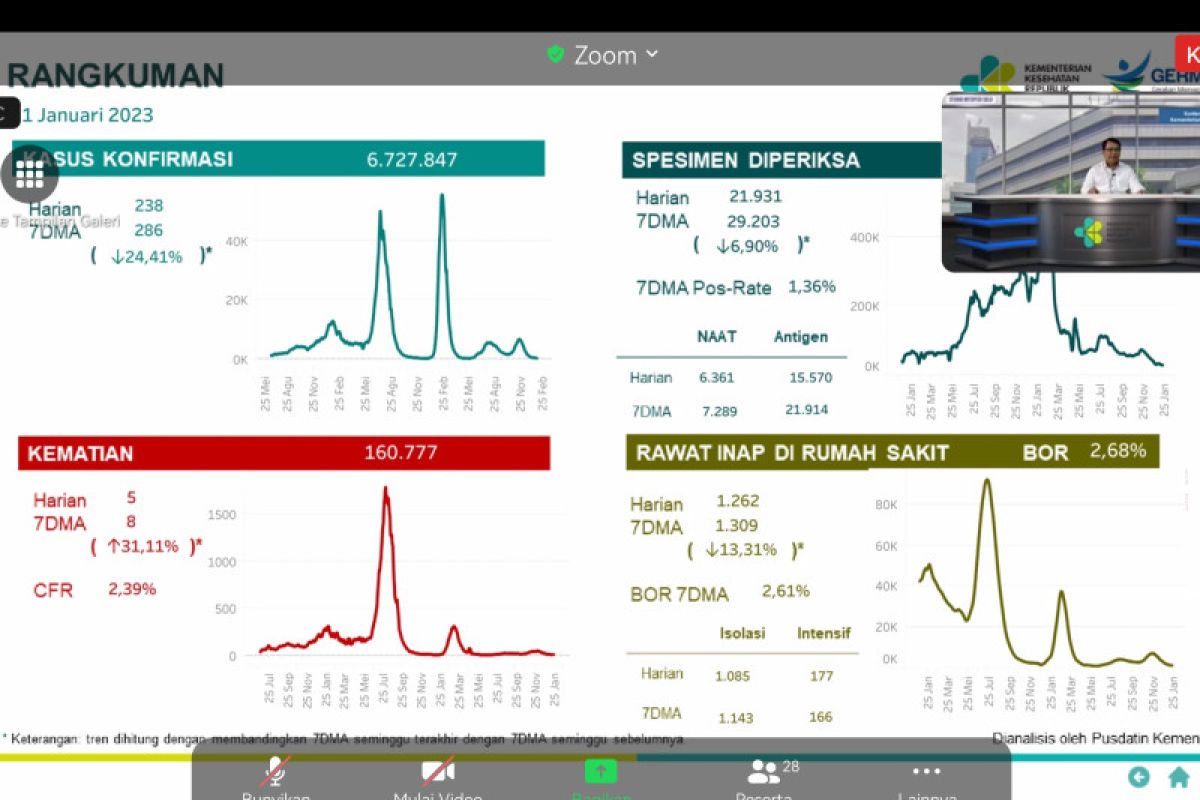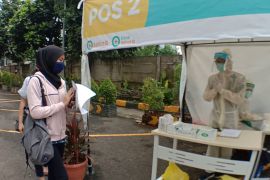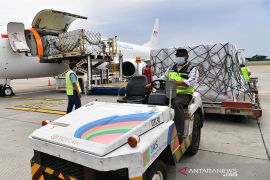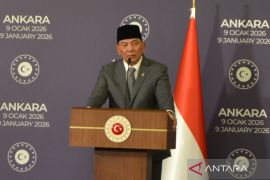This came about as a result of control strategies implemented by authorities.
Minister of Health Budi Gunadi Sadikin deemed two control strategies as being effective weapons in mitigating a potential spike in cases.
These methods comprise the genome sequencing method that serves as a "radar to detect the enemy's strength" as well as the people's body immunity as a "universal defense system".
Indonesia's "radar" capability is strengthened by 56 units of virus, bacteria, and fungus sample test equipment currently available in 41 laboratory networks across all regions in Indonesia, with the reporting capability reaching 2,700 samples per week.
For the "universal defense strategy", a measurement method is implemented to assess the people's antibody levels developed either naturally due to infection or through the government's vaccination program.
The measurement is conducted through routine serological survey conducted every six months.
Related news: Indonesia boosts virus sequencing capacity amid endemic transition
Related news: COVID-19: Jakarta boosts surveillance amid endemic transition
Based on the first and second serological survey, a team from the University of Indonesia's Faculty of Public Health (FKM-UI) reported that Indonesians' defense system to the COVID-19 virus is very high.
It rose, from 87 to 98 percent, with antibody titers having increased from 400 units/ml to 2,000 units/ml.
This capability to develop immunity is proven in terms of epidemiology to prevent domestic case spike, even at a time when new variants are attacking several countries.
The impact of the pandemic in the country to this day continues to consistently decrease within the last few months. The number of daily confirmed cases stood at around 238, or decreased within a week by around 24.41 percent.
The death toll reached eight within a week, and while there has been a slight increase, the figure is still below 10 people, or 2.39 percent.
Meanwhile, the bed occupancy rate is at around 2.68 percent, or decreased by 13.31 percent from the daily report within a week.
The positivity rate indicator as per January 23, 2023, was around 0.88 percent. It showed a downward trend below five percent of the average global cases.
Since January 9, 2023, the BOR is below the WHO standard of a maximum five percent.
The most frequent variants in Indonesia's latest record are XBB and BQ.1, while their predecessors are almost no longer detected in infected patients.
These two control strategies have made Indonesia confident to complete the transition from pandemic to the endemic stage this year, despite the potential for a case spike still existing.
Case import
As quoted from a Reuters' report on January 26, 2022, the Chinese Center for Disease Control and Prevention (CDC) released a report that the COVID-19 daily infection case figure reached more than seven million as per December 22, 2022.
Meanwhile, the death toll on January 4, 2023, reached more than four thousand.
The figure was published a week after government scientists reported that around 80 percent of the 1.4 million Chinese citizens were infected by the coronavirus.
This situation was estimated to trigger an advanced infection wave within the next two to three months.
Before the COVID-19 pandemic struck, the Chinese New Year was known to be a period when the largest annual migration in China occurred.
National immigration administration officials also reported that on average, 500 thousand people traveled in and out of China on a daily basis ever since the restrictions were lifted on January 8, 2023.
According to Indonesian Ambassador to China, Djauhari Oratmangun, 253 thousand international tourist visits from China to Indonesia was a realistic figure to recover Indonesia's tourism economy that had declined due to the pandemic.
On the other hand, the number of tourists from China also triggered concerns that the COVID-19 case figures in Indonesia will increase.
Imported cases due to international travelers certainly remain a serious threat amid Indonesia's positive trend in ending the pandemic, including natural factors that trigger various new virus mutations.
Indonesia managed to detect the latest mutation, the Kraken Omicron, or XBB 1.5, which infected a traveler from Poland while visiting Balikpapan, East Kalimantan, on January 11, 2023.
Kraken is known for its fast transmission capability, though it is not deadly or does not cause hospitalization among asymptomatic patients.
In response, the Ministry of Health conducted tracing of three other residents reported to have had physical interaction with the patient. One of the residents is in Jakarta, while two others are in South Kalimantan. All of them tested negative.
Vaccination
Ever since Omicron dominated other COVID-19 variants in the world, various other strains have surfaced.
Initially, there was the BA.1 variant, then the BA.5 variant, and followed by other strains, including the BQ.1 and BQ.1.1.
Vaccination is the key for universal defense in facing the onslaught of the latest COVID-19 variants that have been emerging recently.
The Ministry of Health issued the Circulation Letter No. HK.02.02/C/380/2023 on Second Booster Dose COVID-19 Vaccination for the General Public.
The goal is to extend the vaccine's protection period, so that the people's antibody levels can continue to be maintained during the transition period toward the endemic.
The fourth dose, or second booster vaccination, initially only targeted health workers and the elderly population, but its scope has since been extended to 70 percent of the general public above the age of 18 years.
Epidemiologist from FKM UI Pandu Riono stated that the strategy to expand the second booster vaccination scope for the productive age group needs to be sharpened only towards targets at the most risk, the elderly.
This is since the vaccination program aligns with the national case spike, or the emergence of more transmissible and riskier new variants that trigger a rise in cases.
Thus, if the scope is expanded to the productive age population, then the number of participants may not meet the target.
The Ministry of Health allocated 9.3 million doses of the COVID-19 vaccine stock, with 7.2 million doses stored centrally, while 2.1 million doses stored in regions.
The available vaccine types comprise 138,185 doses of the Janssen vaccine, 3,344,772 doses of Pfizer, 8,494 doses of Sinopharm, and 189,684 doses of Zifivax.
Rest of the vaccines are domestically produced, such as 1,171,755 doses of InaVac and 4,528,570 doses of IndoVac.
The second booster for the general public is a form of protection after the PPKM was lifted, as it has been over five months since most members of Indonesia's population received the first booster, or third booster.
The people's active role is necessary in developing positive literacy concerning COVID-19 vaccines, including their side effects that are much lower as compared to being infected with COVID-19.
Related news: COVID-19 vaccination must continue despite PPKM revocation: minister
Related news: Indonesia advancing towards COVID-19 endemic stage
Translator: Andi Firdaus, Fadhli Ruhman
Editor: Sri Haryati
Copyright © ANTARA 2023












